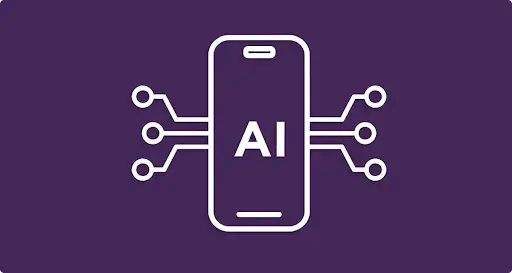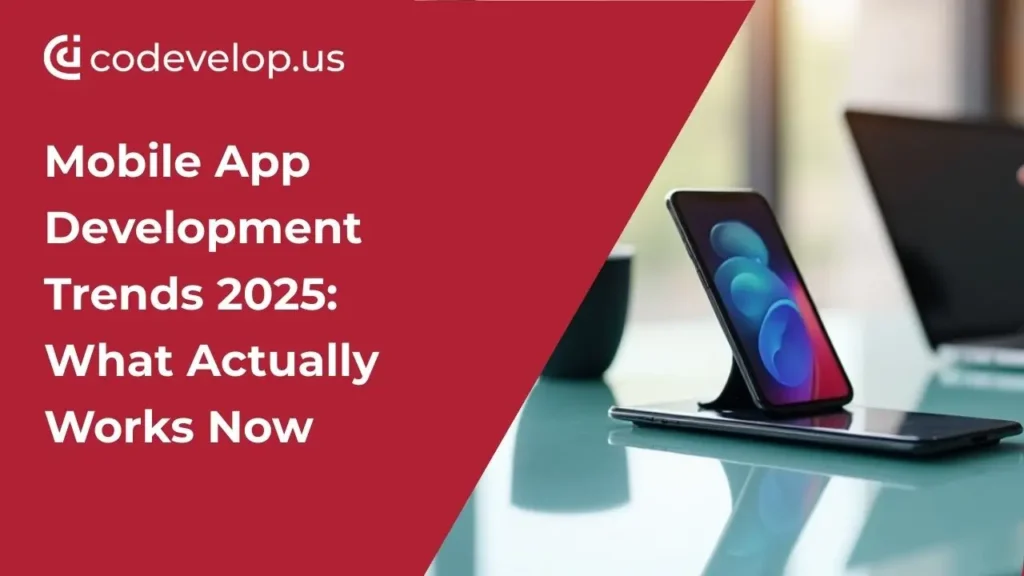The mobile app industry will reach $613 billion in revenue by 2027. Annual app downloads should hit 299 billion by 2025. These numbers paint a clear picture of how mobile app development trends revolutionize our approach to building and using applications.
Mobile technology has never seen such dramatic changes. AI experiments now power 39% of organizations’ mobile strategies. 5G subscriptions will jump from 1.9 billion to 5.9 billion by 2027. The next few years promise exciting developments in app technology. Successful companies already leverage AI personalization, advanced security protocols, IoT integration, and innovative revenue models. At Codevelop, we specialize in creating innovative mobile experiences that actually work. In 2025, the app landscape is evolving fast — but not every “trend” lives up to the hype
This piece highlights practical mobile app development strategies that deliver real results. You’ll learn which breakthroughs matter and which trends are just temporary hype.
The visible shift: how users interact with apps is changing
Mobile apps are changing how users interact with their devices. Touch-based taps and swipes are no longer the only ways to participate with mobile applications. New ways of interacting with devices shape today’s mobile app development trends. These create opportunities for easy-to-use and immersive experiences.
Voice and gesture-based interfaces are going mainstream
Voice User Interface (VUI) technology has become a key part of modern mobile applications. Users can now interact with apps through natural speech commands. The change toward voice-based interaction comes from better VUI technology, users just need hands-free operation, and more available user interfaces.
Voice interfaces offer more than just convenience. Businesses can find new ways to connect with customers and deliver services that set them apart from competitors. Pandora showed this by adding Voice Mode to their app. They won a 2020 Webby award for “Best Branded Voice Experience” and saw high user participation in less than a year.
Gesture-based interfaces reshape how we interact with mobile apps among other innovations. Users control applications through natural movements that mirror ground actions:
- Navigational gestures for moving between screens (swiping, pinching)
- Action gestures for taking specific actions (tapping, long-pressing)
- Transform gestures for manipulating content (rotating, shaking)
Gesture-based navigation creates cleaner interfaces and improves task completion rates. One designer said, “Animation paired with gesture-control essentially tricks the brain into thinking that it’s interacting with something tangible”. Note that gestures are hidden controls that users must memorize, which makes visibility a significant design principle.
Foldable and wearable devices just need adaptive design
Foldable devices bring unique challenges and opportunities for mobile app developers. These trailblazing smartphones and tablets with flexible screens can switch between different form factors. This creates a fundamental change in app design approaches.
Foldable devices work in various states, including FLAT (fully open) or HALF-OPENED configurations. Partial folds create either “tabletop posture” (horizontal fold) or “book posture” (vertical fold). Each offers unique layout possibilities. Foldable smartphones make multitasking easier as users work with multiple apps at once.
Wearable technology leads the next wave of technological innovation. Smartwatches, fitness trackers, smart glasses and smart clothing need optimized interfaces that fit their unique features.
Adaptive design solves the challenges for both foldable and wearable devices. This creates different layouts optimized for various display sizes and configurations. Unlike responsive design that adjusts a single layout, adaptive design uses specific layouts for different resolutions. This allows precise customization for each screen type.
Successful adaptive design requires:
- Screen layouts that work together for a smooth user experience
- Apps that keep their state when switching between folded and unfolded screens
- Important content stays visible in all device states
Mobile app development points toward more natural, contextual interactions. Technology adapts to human behavior with voice commands, natural gestures, and adaptive layouts for new devices.

AI and personalization: the new standard in mobile UX
AI integration has become the life-blood of exceptional user experiences in modern mobile applications. Traditional apps offer a one-size-fits-all approach. AI-powered apps understand individual priorities, adapt to user behavior, and predict future needs. They create tailored experiences that users now expect.

How AI is powering smarter, context-aware apps
Context-aware applications mark a significant advancement in mobile UX. They sense and understand users’ situational environment. These intelligent systems gather information about users’ current state and process this data. They adapt their behavior to make technology available to everyone, whatever their technical expertise.
Context-aware apps work on four critical processes:
- Acquisition: Monitoring and capturing contextual information
- Modeling: Designing representations of ground entities and environments
- Distribution: Delivering context to applications and interested entities
- Reasoning: Deducing new knowledge based on available context
These apps revolutionize user experience by utilizing AI in the background. They improve interactions without getting in the way. AI makes interactions faster and more convenient through chatbots that provide instant answers and recommendation systems that suggest relevant products. Users barely notice its presence.
A PwC report shows that 63% of consumers expect AI to make their digital experiences more tailored. Developers create smarter interfaces that learn continuously from user interactions. Transparency remains vital—a 2023 Statista report showed that 58% of consumers globally would avoid AI-driven services if they believe the technology lacks transparency or is unethical.
Predictive analytics and behavior-based personalization
Predictive analytics drives next-generation mobile personalization like a “crystal ball for future growth”. Complex algorithms and machine learning analyze historical data. Mobile apps can anticipate user needs before they’re explicitly expressed.
Successful mobile apps use several types of predictive models:
- Time series models identify patterns like seasonality and trends in data collected at consistent intervals
- Classification models predict discrete outcomes or user actions
- Regression models forecast continuous numerical values
- Clustering models segment users based on behavior patterns
These sophisticated models enable powerful personalization strategies. Spotify shows this through its “Discover Weekly” and “Release Radar” playlists. The app analyzes listening habits, skip patterns, and genre priorities to predict which streams users might enjoy. Netflix’s recommendation engine learns from viewing behavior to improve content suggestions.
Such personalization substantially affects business. A major news website’s recommendation system increased page views per session by 30%. Subscription rates rose by 15%, and user retention rates grew by 20%. Tailored push notifications show 4X higher open rates compared to generic messages.
Predictive analytics gives valuable operational insights. App developers can forecast sales for in-app products and identify items likely to perform poorly. They can predict cash flow for proactive decision-making. The technology helps identify high-value user segments and users at risk of churning, which enables targeted retention strategies.
The integration of AI with UX design will accelerate toward 2025. AI literacy will become essential for success in any tech-related field. The main challenge lies in balancing AI capabilities with human-centered design. These technologies should improve rather than complicate user experience.
The tech backbone: what’s powering the future of mobile apps
A robust technological infrastructure powers every smooth user experience and AI-driven feature in mobile apps. The rise of this tech backbone shapes the future of mobile apps in 2025.
5G and cloud computing for faster, lighter apps
5G networks continue to expand worldwide. Projections show 5G will reach 45% of the global population by 2025. This technology goes far beyond a simple upgrade. It runs 10 times faster with 100 times more capacity than 4G. Developers can now build apps with instant responsiveness that wasn’t possible before.
Cloud computing plays a crucial role in modern app development. Today’s apps utilize cloud systems instead of storing everything on the device. This creates “lighter” applications that save device resources while delivering powerful features. Apps based in the cloud can cut local storage needs by 60% without losing performance.
IoT integration for connected experiences
The Internet of Things (IoT) market will grow to $1.3 trillion by 2026. This growth completely changes how mobile apps work with physical devices. Apps now act as control centers for networks of connected devices—from smart homes to industrial equipment.
This integration enables:
- One interface to manage multiple devices
- Smart actions based on live sensor data
- Smooth transitions between physical and digital experiences
Healthcare shows this change clearly. About 73% of medical devices will connect to networks by 2025. Mobile apps now track patient vitals, medication use, and treatment results across many connected medical devices.
Blockchain for secure and transparent transactions
Blockchain technology has grown beyond cryptocurrency into a powerful tool for app security and transparency. Enterprise blockchain spending will reach $19 billion by 2024, showing its growing role in business applications.
Blockchain mainly solves critical trust issues in mobile apps by creating permanent records of transactions and interactions. Apps using this technology offer better security for financial transactions. Some implementations cut fraud by up to 40%. Supply chain management apps also use blockchain to create clear product tracking that customers can check on their phones.
These technologies keep evolving and blur the line between device and cloud operations. The mobile app of 2025 becomes a gateway to big networks of connected devices, cloud services, and secure distributed systems rather than standalone software.
Commerce and monetization: where mobile apps are making money
Mobile app development’s financial world keeps changing as users accept new payment methods and service delivery models. New ways to make money have become crucial for app success. Developers who understand changing consumer behaviors now have unprecedented revenue opportunities.
Mobile wallets and contactless payments are now expected
Digital wallets have become the preferred payment method for mobile users worldwide. McKinsey’s 2022 report shows digital wallet usage like Apple Pay and Google Pay increased to 89% that year and will reach 100% in coming years. Users prefer contactless payments because they offer better security through point-to-point encryption and biometric authentication compared to traditional methods.
The market shows strong growth. Mobile wallet transactions will grow from USD 6.10 billion in 2019 to USD 13.98 billion by 2023. The global mobile wallet market will reach about USD 88.36 billion by 2030, growing at a remarkable CAGR of 27.20%.
Developers must now include payment gateway functionality. These features are must-haves:
- Easy money transfers between accounts
- NFC and QR code support for in-store payments
- Integrated loyalty and rewards programs
- Strong security measures and fraud prevention
On-demand and super apps revolutionize user expectations
On-demand services have changed how users interact with mobile applications. The on-demand app market will reach USD 335.00 billion by 2025. User numbers should hit 1.97 billion globally.
Super apps—platforms that combine multiple services under one interface—are the next big thing in mobile commerce. These platforms will generate USD 426,005.80 million by 2030, with a CAGR of 27.8% from 2023.
These detailed platforms create multiple revenue streams through:
- Subscription models (over 60% of Americans use at least one subscription-based service)
- Transaction fees on in-app purchases
- Advertising opportunities in a variety of services
- Featured listings for integrated micro-apps
Super apps let businesses control the customer’s entire experience—from browsing to payment to delivery. This creates opportunities for cross-selling and deeper user involvement.
Designing for trust: privacy, security, and compliance
Trust serves as the bedrock for successful mobile applications in 2025. Security vulnerabilities plague about 75% of mobile apps. Companies must invest in strong security and privacy measures as a vital business strategy.
Why app security is a competitive advantage
Companies that make app security a priority gain significant advantages in today’s ever-changing market. Strong mobile app security serves as a unique selling point for 95% of businesses. Users have become more aware of security risks. Data security and privacy concerns now worry 67% of smartphone users – a 13% rise from previous years.
Security excellence does more than prevent breaches – it shapes how consumers behave. Only half of consumers feel the value from online services balances their privacy worries. Brands that show strong security practices earn trust faster. They speed up sales and keep customers longer.
Money matters tell a clear story. A single mobile app security incident costs around $5 million. The damage goes way beyond the reach and influence of immediate financial losses. Security breaches destroy customer trust. Brand reputation suffers long-term damage that takes years to fix.
Privacy-first design and user consent features
Privacy by design has evolved from theory to necessity in mobile app development. This method builds privacy protections into products from the start instead of adding them later. Key principles include:
- Proactive prevention rather than reactive remediation
- Privacy as the default setting requiring minimal user action
- Full functionality without compromising data protection
- End-to-end security throughout the data lifecycle
- Transparency in all data collection practices
User consent management plays a vital role in privacy-first design. GDPR requires mobile app consent to be explicit. Clear “accept” and “decline” options must appear equally. These choices need simple language – Google suggests writing consent messages at a 13-year-old reading level.
Studies show that 80% of businesses saw increased customer loyalty after investing in privacy. Returns typically range from 60% to 100%. These numbers prove that focusing on transparency and user privacy leads to higher customer lifetime value.
Mobile applications that combine strong security measures with thoughtful privacy design will lead the market in 2025.
Conclusion
Mobile app development has reached a turning point where technology meets what users want. New trends constantly emerge, but only a few prove their worth through real results and user adoption.
Apps today are more user-friendly than ever thanks to AI-powered personalization and advanced controls like voice and gesture. The reliable 5G networks and cloud computing enable these advanced features without slowing down performance.
Modern mobile apps need three elements to succeed. They must adapt to how people use their devices through super apps and digital payments. The core team should build strong technical foundations that support IoT and blockchain. Users’ security and privacy must remain a priority to maintain their trust. At Codevelop, we believe great apps aren’t just built on trends — they’re built on purpose. We help businesses unlock the full potential of mobile by designing apps that are future-ready and user-focused.
These patterns show where mobile app development is heading through 2025 and beyond. Developers who want to stay ahead will create apps that combine smooth user experiences with strong security. They’ll use new technologies to add real value instead of following temporary trends.
FAQs
Q1. What are the key mobile app development trends for 2025?
Key trends include AI-driven personalization, voice and gesture-based interfaces, 5G and cloud computing integration, IoT connectivity, and blockchain for secure transactions. Additionally, there’s a shift towards super apps and on-demand services, along with a strong focus on privacy and security.
Q2. How is AI changing the mobile app user experience?
AI is powering smarter, context-aware apps that can understand individual preferences, adapt to user behavior, and predict future needs. This leads to more personalized experiences, such as tailored content recommendations and intelligent chatbots, enhancing overall user satisfaction and engagement.
Q3. What role does 5G play in the future of mobile apps?
5G technology is set to revolutionize mobile app development by offering significantly faster speeds and lower latency. This enables the creation of more complex applications, supports real-time responsiveness, and opens up new possibilities in areas like augmented reality, healthcare, and IoT integration.
Q4. How are payment methods evolving in mobile apps?
Mobile wallets and contactless payments are becoming standard features in apps. Digital wallet usage is projected to reach 100% in the coming years, with the global mobile wallet market expected to hit USD 88.36 billion by 2030. This shift is driven by increased security and convenience for users.
Q5. Why is app security becoming a competitive advantage?
With growing user awareness of data privacy risks, robust app security has become a unique selling point. Nearly 95% of businesses report that strong mobile app security is a competitive advantage. Prioritizing security and privacy helps build user trust, accelerates sales cycles, and increases customer loyalty.


